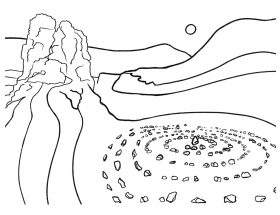On September 29th, at around 2.30 or so (I know it was then because lunch was done and yet dinner was still far off), I felt very strange. I was feeling– well, what was I feeling? I suppose the word is discomfort.
Yes.
I was uncomfortable. I was – well, I was…. Hey Siri? How do I girlishly and sexily tell the public that my down-below area was in some sort of ambiguous trouble?
By nighttime I decided I had what I presumed to be Vaginal Candidiasis, otherwise lovingly known as a Yeast Infection, for all you medical laymen out there.
I went to bed strategizing. The next morning I would waddle into town to buy all the necessary medicines I needed to enact the siege I had planned on myself. Glory, and a comfortable down-there-area (is this term better or worse than just saying vagina outright?), would be mine.
The siege, to put it lightly, failed, leaving my condition to worsen. And while that makes me sound like a Victorian woman with Scarlet Fever, by October 2nd I knew I was experiencing something unprecedented to myself.
October 3rd rolled around and I dragged my sexy, feminine, and bacteria-ravaged body back to the pharmacy. I recruited the newest additions to my pain-fighting cavalry, and felt certain I would emerge fruitful in the battle to come.
On October 6th, a painful three days later, I would find myself in the midst of a public street turning paler than translucent, my lips fading to the color of an eerie violet, back with shooting pains, stomach cramping intensely, and my hands shaking uncontrollably. As I dragged myself home, almost blind with a forehead damp from sweat, I thought some sleep and a piece of toast would cure me of my debilitating case of whatever-this-was.
Five hours later, I would find myself lying on a hospital table with an Italian doctor pressing his cold and slender fingers heavily on my kidneys, as the faint noise of ‘I’m a Celebrity, Get Me Out of Here!’ playing on the waiting-room TV hummed around us.
“UTI” he said calmly as I winced at his poking on my tender stomach, “The infection has probably risen to your kidneys now.”
You, understandably, are probably wondering why I’ve just given you extensive details on my most recent vaginal escapades. To be fair to you, it is uncharacteristic. I don’t really like to discuss medical and personal details as such openly unless it is with close friends and family. It certainly doesn’t feel normal to casually bring up the off-kilter PH balance of my vagina in a magazine like this (one which my peers, friends, past-teachers, and family will most-likely read). But I’ve taken you on this walk down medical-memory lane because, in the midst of cursing my tender kidneys as I lay in bed gripping my back, I realized that had I been born a century earlier, this incident wouldn’t have been some funny anecdote. Rather, an avoidable one-way ticket to a casket.
I have had this thought almost every time something has gone (please make serious note of the quotation marks) “wrong” with my health as it relates to female genitalia and reproductive systems. As I cavalierly google symptoms, call my mother, chat to friends about our shared experiences, and buy the recommended treatments from my local Boots (sans awkwardness or shame), I think of how a mere 50 years ago, women were progressively crushed beneath the weight of taboo– one that sat upon the concept of vaginal health and sneered. Moreover, male hegemony and the perceived superiority of cis-men on socio-cultural, political, and economic scales meant that female health and sexuality went largely under-studied or highly over-generalised.
In Ancient Greece, the Hippocratic Campus cited one of the ‘Diseases of Women’ to be what was called “wandering womb”; this was the belief that the uterus could displace itself and move around the female body, causing an array of mental and physical health issues. Plato’s dialogue Timaeus described the uterus as a living thing that could block passages, obstruct breathing, and actively cause disease. By the 2nd century, famous physician Galen expanded upon the concept of “wandering womb”. A book by Gilman (and more) describes Galen’s belief that “widows, and particularly those who previously menstruated regularly, had been pregnant and were eager to have intercourse, but were now deprived of all this” were most likely to suffer from ‘wandering womb’. He listed treatments for the affliction as being sexual intercourse (obviously) and scent therapy, in which scents were placed below the nose or the vagina to ‘lure’ the womb back into place (are we sure Gwyneth Paltrow hasn’t giddily tried to sell us this on Goop before?). For Galen, the retention of menstrual blood in the uterus was problematic, but more so was what he called, ‘the female seed’. This was presumed to be the feminine equivalent of semen, thought to reside in the womb. The belief followed that without the regular ‘release’ of the semen through climax or intercourse alone, the female seed turned venomous, and caused a variety of physiological and psychological issues.
I’m sure you’ve heard of ‘hysteria’ before. This is where it began. Eventually, it became an extremely common medical diagnosis for those with female reproductive organs. The symptoms? Anxiety, shortness of breath, fluid retention/bloat, irritability, sexual desire, loss of sexual desire, sexually forward behavior, insomnia, and acting in a ‘non-agreeable’ way. Today, hysteria is more commonly referred to as ‘normal female sexuality’. Sounds horrifying! Hysteria has such a dark history because–besides the medical get-out-of-jail free card it gave physicians to engage in sexual conduct with their patients, and the blatantly misogynistic narrative the concept itself pushed–the diagnosis could at times lead to hysterectomies being performed, as the uterus was considered the root of the problems.
Hysteria grew to embody some more social factors. The article ‘Women and Hysteria in the Age of Mental Health’ details how, by the modern age, thinkers like René Descartes believed that actions “attributed to the soul” were connected to the organs. This was built upon by physician Thomas Willis who believed that hysteria was not connected to the uterus alone, but instead the female brain (are you catching my sexist-drift here?). Pierre Roussel and Jean-Jacques Rousseau hypothesised that the frequency of hysteria resulted from the unfulfillment of a feminine appetite; this meant that if a woman was not fulfilling the basic tenets of femininity she would fall victim to hysteria (uterine-revolution in the name of the-cult-of-domesticity sort of stuff. You get it).
In the shadow of all this sort-of-sordid history, I imagine myself in the Age of Enlightenment turning translucent and shaking. I wonder if the doctors would have assumed my ‘female seed’ had turned venomous. I wonder if my prescription would have been smelling salts and intercourse. My condition would have without a doubt worsened. A kidney infection can get complicated quickly. My scarlet fever joke feels a tad more sinister now.
Aside from this all, I also can’t help but wonder if society would be medically advanced to a greater degree had it not been for the presumption that biological objectivity always aligns with societal assumption. Don’t get me wrong, all medicine from the past was wonky (seriously, what the hell was with blood-letting?), but I think that the gender-norm approach to the female body – the belief that the uterus was it’s own ‘creature’ that was outraged when a woman felt sexual desire and decided to enact its rage by making her bloat – may have blinded physicians from making actual medical advancements.
This is what I have decided to call pockets of marginalisation (is this a thing? Did I steal this? I can’t find the term anywhere except for casually in a UNESCO document but I feel like some anthropology professor has probably said it before). Pockets of marginalisation are areas in which we overlook details as they apply to specific marginalised groups, and as such, lose a great deal of information that could be useful not just to that one group, but to medicine or society as a whole.
An example of this is the study of autism spectrum disorder. An article published in Scientific American recounts the surprise felt by Yale University autism researcher Kevin Pelphrey when his own seven-year-old daughter was diagnosed with autism– something he never noticed in her. Pelphrey now believes that this was due to the fact that the criteria used for diagnosing autism was reliant on data derived almost wholly from studies on men, which has in turn blindsided doctors and researchers from seeing how symptoms for women may be significantly different. The disorder, as the article says, “was thought to be at least four times more common in boys than in girls”. The revelation that symptoms can manifest themselves as outliers from the existing criteria has led researchers to wonder if this statistic is true, or if many women and girls have gone undiagnosed. By leaving women unconsidered in the study, the ability researchers, specialists, and physicians once had to speak confidently on autism has been undermined.
For people of colour, this article has probably not surprised them in the least. As a group consistently neglected from genuine medical studies intended to advance knowledge and treatment, the concept of medicine being tailored for someone other than yourself is an unfairly common feeling amongst communities of colour. In an article published by the Atlantic, Illyasha Peete discusses her fear regarding her asthmatic sons health as she details that “they send you home with this child, and you know he could stop breathing at any minute”. Worse still is that as the Bay Area executive director of the nonprofit Breathe California, Peete also knows that most of the treatments her son will receive are based on information regarding white European-Americans. This is detrimental, says an Immunogenetics study from UCSF, as only 5% of the genetic traits connected to asthma in European-Americans applies to African Americans. Furthermore, co-author of the study Esteban Burchard says that other studies have highlighted that different ethnicities have “distinct genetic mutations that increase their risk for particular diseases and affect how they respond to medicine”. The disregard of such information – the active neglect of these details in research – has meant that African American children have died from asthma at ten times the rate of White children.
It doesn’t end there.
Gianna Melillo’s article in the AJMC has revealed that racial bias can affect minority participation in oncology clinical trials, leaving a significant portion of the population under-studied when it comes to treating cancer. In 2019 the Centers for Disease Control and Prevention reported that African American, Native American, and Alaska Native women die of pregnancy-related complications at a rate of three times higher than White women.
This is where the notion of ‘the pocket’ comes into play. Certain subversive forms of inequality (the neglect of minorities from medical studies, for instance) seem like minutiae to those whom the inequality does not apply. To them, the fact that the studies were done is what matters. Therefore, the supposedly incognito existence of these types of marginalisation leaves social hegemons to do very little in addressing them and at times, prevents them from seeing it the first place.
The point of this article is to make a case for exposing these pockets of marginalisation, locating the needs that exist within them, and engaging those victimised by them in the production of future and better work. When we include marginalised peoples into processes of knowledge, not only do we expand upon the general database of important knowledge as it relates to those particular groups, but we in fact advance societal ability and understanding as a whole. This applies not only to medicine, but to law, architecture, philosophy, politics, transportation, linguistics, and more that I don’t have the intelligence to recall.
Put simply, when we search for and listen to those we leave behind, we often find large-scale progress.
I think the importance in finding these pockets of marginalisation and eradicating them is most aptly exemplified in a Ted Talk done by Elise Roy, a disability rights lawyer and design thinker. Roy is herself deaf, and she cites going deaf as “one of the greatest gifts she has ever received”, as it allows her to experience the world in a unique way. This unique perspective, she explains, is what will “help us make and design a better world for everyone — both for people with and without disabilities”.
Roy has a master’s in social design, and is a big proponent of ‘design thinking’, a form of creative and innovative problem-solving made to make us “look sideways, to reframe, to refine, to experiment” and to ask “stupid questions”. In her talk, Roy relates her love of design thinking as being a way in which she approached common inconveniences she would run into as a result of her deafness.
“I fell in love with woodworking. But what I quickly realized was that I was missing out on something. As you’re working with a tool, right before it’s about to kick back at you — which means the piece or the tool jumps back at you — it makes a sound. And I couldn’t hear this sound. So I decided, why not try and solve it? My solution was a pair of safety glasses that were engineered to visually alert the user to pitch changes in the tool, before the human ear could pick it up. Why hadn’t tool designers thought of this before? Two reasons: one, I was a beginner. I wasn’t weighed down by expertise or conventional wisdom. The second is: I was Deaf. My unique experience of the world helped inform my solution.”
Roy continues on to ask the audience why we design first for ‘the norm’ and second for disability, when designing for disability often leads to technological or architectural advancements the general public prefers.
“Text messaging: that was originally designed for people who are Deaf. And as you know, everybody loves that, too.”
Roys argument for designing with disability in mind is one that has stuck with me since I first heard it in 2016. Her genius isn’t revolutionary, but it is something that has often gone overlooked. The idea that thinking outside of your own scope to create more helpful, more knowledgeable, and more innovative inventions is almost obvious. It’s a shame that the word almost has to be included at all.
The fact that pockets of marginalisation are hurting specific peoples should be reason enough to attempt to eradicate them. Sadly, in this world, it isn’t. Oftentimes to persuade the norms of cultural hegemony we must shift the norms themselves. If we can’t convince people to care about others, we can try to convince them to care about themselves. That is when we ask: What type of world could we be living in, what sort of things could be known or made or explored, if we had considered that people are not homogenous? If we had included all sorts of people in our production of society?
I suppose I can’t end this article with a specific solution (I’d probably be an already famous revolutionary if I could). My best guess, however, is that we listen to people when they identify pockets of marginalisation – that we are conscious of their existence even when they don’t apply to us – and, instead of fighting against their needs, we create collaborative steps towards a solution.

Art by Quinn Fagersten





So thorough in the parallel you draw between the marginalization and trivialization of women’s health issues 60+ years ago (in all of its ridiculousness to our modern sensibilities) and the current ways in which health issues and treatments still fail to account for the variations of experience that may come with different groups outside the hegemonic “norm”. Bravo, Jade!